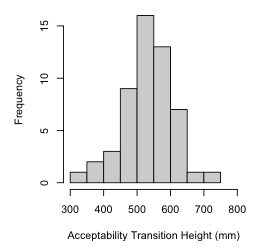Findings
Driver Preference for First-Step Height
Objective: Use subjective response data to quantify driver preferences for first-step height and compare the results to current recommendations.
Method: Subjects rated bottom step heights ranging from 203 to 787 mm after entering and exiting the mockup many times with the bottom step at a height of 406 mm and the top step at a height of 838 mm. Starting at a step to ground height of 203 mm, subjects were instructed to step up onto and then down from the step with both feet while maintaining grasp of the inner door handle and the rear exterior handle. Subjects were then instructed to face away from the mock-up and rate the acceptability of the step height on a scale from 1 to 4, with anchors of very acceptable, somewhat acceptable, somewhat unacceptable, and very unacceptable. Drivers were instructed to respond “as if you are going to be getting in and out of the truck 10 times per day.” With the subject facing away from the mock-up and unable to see how step height was being altered, step height was increased an amount based on the subject's rating. The procedure was repeated until step height reached a predetermined value or a rating of 4 (very unacceptable) was given.For most trials, step height was then increased an additional 1 inch, and the procedure was repeated. From then on, step height was decreased by 1 inch each trial and testing stopped when a rating of 1 (very acceptable) was given.
For quantification of step height preference and for use in data analysis, a variable called “acceptability transition height” was calculated. The step height at which the subject switched from rating step height acceptable (1 or 2) to unacceptable (3 or 4) was found for the trials of increasing step height. This was done by taking the average of highest step height the subject rated acceptable (1 or 2) and the lowest step height the subject rated unacceptable (3 or 4). The unacceptable to acceptable transition height for decreasing step height trials was found in the same manner. These two transition values were averaged for each subject. For the purposes of statistical modeling, subjective ratings were converted to a binary scale, either acceptable (rating 1 or 2) or unacceptable (rating 3 or 4). Logistic regression was performed in software package R (www.r-project.org) and analysis of variance (ANOVA) of nested factor models was conducted to assess the effects of age, BMI, gender, stature, driving experience and knee height on acceptability ratings.
Results: The distribution of acceptability transition heights is shown in the histogram in the figure. Acceptability transition heights ranged from 330 mm to 711 with a median of 533 mm. No significant relationship was observed between preferred step height and age, BMI, gender, stature, driving experience, or knee height. Although too few subjects rated any step height "very unacceptable" to investigate the rating 3 to rating 4 transition height, the rating transition of 1 to 2 was investigated. This transition also did not show any apparent correlation with subject-based factors. Logistic regression analysis showed that only step height, and not subject variables, predicted subjective response level.
Using the logistic regression model, driver acceptance of current industry standards for first step height were calculated. The model was also used to predict driver acceptability of bottom step heights measured on real trucks. Of the 67 trucks measured, the mean first step height was 426 mm with a standard deviation of 51 mm (ranged 247 to 527 mm).
Key Findings:
• Driver preferences for first step height can be quantified using a rating procedure.
• Driver preferences for first step height are not importantly related to body dimensions.
• A simple logistic regression model was developed that can be used to assess the consequences of changes in first step height.
• Driver preferences for first step height are largely consistent with the broad range of recommendations in current standards.

©2017 University of Michigan